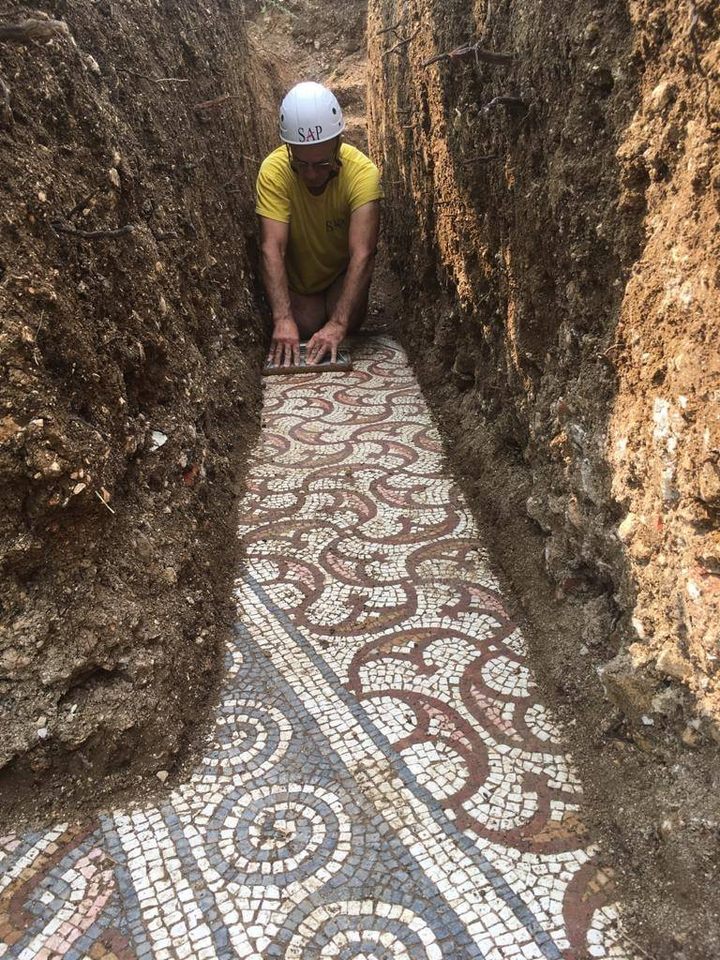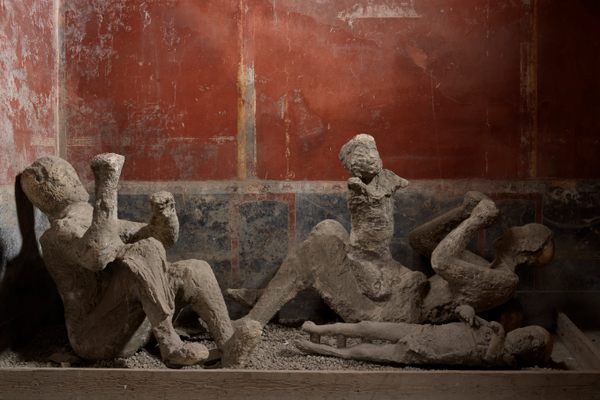
Unearthing a Roman Villa Under a Working Vineyard
Its stunning mosaic floor luckily escaped root damage.
Nestled between the Alps and the city of Verona, the Valpolicella—literally the “valley of many cells” in Latin—has been a renowned winemaking region going back at least to Roman times. In the first century, Pliny the Elder wrote about how people near Verona made wine: “They gather their bunches into stone barns and let them dry until winter, when they make wine from them.” Some places still make it like they used to: Regional wines, such as Amarone, are still made using partially dried grapes, a technique that was common during the Roman Empire.
Recently, archaeologists have unearthed signs of the former Roman residents of Valpolicella—appropriately right below an operating vineyard. In May 2020, a team of government archaeologists unearthed an intricately patterned mosaic pavement dating to the third or fourth century. But it wasn’t an entirely unexpected discovery.
Archaeologists have been looking for this mosaic since at least 1922,” says Alberto Manicardi, head of operations for the dig, near the town of Negrar. “We knew it was there but were not able to exactly locate it.”
The villa, dating to the third or fourth century, was first discovered by chance in 1887, when farmers came across Roman-era remains, including fragments of an elaborately decorated mosaic pavement, just inches below the surface of a field.
The first archaeological excavation there was conducted in 1922, and an area of 885 square feet was unearthed. But the then-owner of the property reburied the remains and planted vines on top.

In recent decades, archaeologists have resumed the quest for the full mosaic and the rest of the large villa. Renderings based on that first excavation indicated that those mosaic fragments belonged to a much wider floor, probably part of the main reception room.
But looking for mosaics in a fully functioning vineyard is not easy. “Luckily, winemakers understood the importance of our search and allowed us to work in their fields,” Manicardi says. To avoid unnecessary damage to the vines, the archaeologists used a mix of noninvasive techniques, such as ground-penetrating radar and limited trial trenches, to explore what was beneath the surface without a full-blown excavation.
“In summer of 2019 we located a portion of the mosaic, as well as structural elements like walls and stairs,” explains state archaeologist Gianni de Zuccato, who lead research efforts in the vineyard. Inspired by the promising findings, the team kept looking, but had to stop when harvest season came along in early fall, and again during the coronavirus pandemic. Works could only resume in early May, when Italy’s nationwide lockdown was eased.
On May 18, the long-lost mosaic pavement was finally located, under around 4.5 feet of fertile earth. “For the most part it is really well preserved,” says Manicardi, adding that only small portions of the 29-by-22-foot surface were disturbed by sprawling vine roots—fortunate, since they can grow down to 30 feet.

This part of Valpolicella is known for its volcanic soil—with violet and pink pebbles—that results in distinctively smoky and meaty red wines such as Amarone. Some of those same pebble colors appear in the mosaic—small white, pink, yellow, and violet stones resulting in remarkably vivid designs, says De Zuccato.
The mosaic design, featuring a series of twisted shapes known as “Solomon’s knots” inscribed in octagons and rhomboids, will help experts investigate the identity of the homeowner. As explained by archaeologist Federica Rinaldi in a recent study, he was probably a wealthy Roman officer. Other notable finds include a ring, a bracelet, and a coin with the emblem of Lucius Verus, who co-led the Roman Empire with his adoptive brother Marcus Aurelius between 161 and 169.
But the century-long coexistence of winemaking and archaeological exploration may be at its end. To fully unearth the 10,000-square-foot villa, the archaeologists may need to ask winemakers to stop production entirely. “Thanks to these findings the area was finally declared of national cultural interest,” De Zuccato says. “We now need to secure funds for a full excavation.”
The mayor of Negrar, Roberto Grison, hopes that the vineyard will become an archaeological site open to the public. “We will work with local cultural institutions and property owners,” he told local newspaper L’Arena. “We will find a way to make this treasure accessible to the public.”













Follow us on Twitter to get the latest on the world's hidden wonders.
Like us on Facebook to get the latest on the world's hidden wonders.
Follow us on Twitter Like us on Facebook